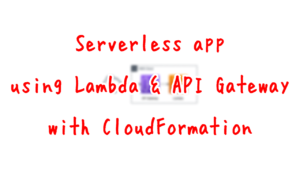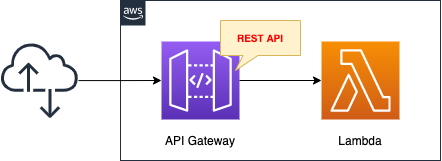Create REST API type API Gateway using CloudFormation
The following page covers the HTTP API type API Gateway.

In this article, we will check how to build a REST API type API Gateway.
Environment

Create an API Gateway and deploy Lambda on the backend.
When an HTTP request is received from a user, the API Gateway acts as the endpoint, calls a Lambda function instead, and returns the result of the function’s invocation to the user.
The API Gateway is created as a REST API type.
The runtime environment for the Lambda function is Python 3.8.
CloudFormation template files
The above configuration is built using CloudFormation.
The CloudFormation template is located at the following URL
https://github.com/awstut-an-r/awstut-fa/tree/main/052
Explanation of key points of template files
To create an API Gateway with Lambda backend, prepare the following 6 resources.
- API Gateway itself
- Resource
- Method
- Integration
- Deployment
- Stage
The next thing to check is the version of API Gateway.
Broadly speaking, there are two versions of API Gateway.
One is the REST API version and the other is the HTTP or Websocket API version.
In CloudFormation, both versions are separated as resources.
For example, when defining a REST API type API Gateway itself, the Type property is “AWS::ApiGateway::RestApi”.
Next, when defining the REST API type API Gateway itself, the Type property is “AWS::ApiGatewayV2::Api”.
API Gateway itself
Resources:
RestApi:
Type: AWS::ApiGateway::RestApi
Properties:
EndpointConfiguration:
Types:
- EDGE
Name: !Ref Prefix
Code language: YAML (yaml)The point is to specify the API endpoint type for the REST API.
The REST API has three API endpoint types.
The API endpoint type can be edge-optimized, regional, or private, depending on where the majority of your API traffic originates from.
Choose an endpoint type to set up for an API Gateway API
By default, the edge-optimized API endpoint is selected, so we’ll specify this one.
Incidentally, this API endpoint type is unique in that it is delivered via CloudFront.
An edge-optimized API endpoint is best for geographically distributed clients. API requests are routed to the nearest CloudFront Point of Presence (POP). This is the default endpoint type for API Gateway REST APIs.
Choose an endpoint type to set up for an API Gateway API
This means that if you choose this API endpoint, it will be delivered via CloudFront by default, without the user having to put CloudFront in front of the API Gateway themselves.
Resource
AWS officially describes resources as follows
Each API resource can expose one or more API methods that have unique HTTP verbs supported by API Gateway.
Amazon API Gateway concepts
In other words, an API Gateway resource is equivalent to a portion of the PATH in the API endpoint URL you create.
Resources:
Resource:
Type: AWS::ApiGateway::Resource
Properties:
ParentId: !GetAtt RestApi.RootResourceId
PathPart: !Sub "${Prefix}-resource"
RestApiId: !Ref RestApi
Code language: YAML (yaml)There are two key points.
The first is the PathPart property.
As mentioned earlier, an API Gateway resource corresponds to a string that constitutes the URL of an API endpoint.
In this case, the built-in function Fn::Sub is used to specify “fa-052-resource” for this property, and this value is the following part of the URL.
https://[api-endpoint]/[stage-name]/[resource-name]/
The second point is the ParentId property.
This property specifies the parent resource of the API Gateway resource to be created.
This is because API Gateway resources are a tree structure based on a root resource.
API resources are organized in a resource tree according to the application logic.
Amazon API Gateway concepts
In this case, the resources are tied directly under the root resource.
We use the built-in function Fn::GetAtt to get the ID of the root resource from the API Gateway itself and set it to this property.
Method and Integration
The methods are as quoted above.
That is, they correspond to HTTP methods such as GET and POST.
Resources:
Method:
Type: AWS::ApiGateway::Method
Properties:
AuthorizationType: NONE
HttpMethod: GET
Integration:
ConnectionType: INTERNET
Credentials: !GetAtt ApiGatewayRole.Arn
IntegrationHttpMethod: POST
Type: AWS_PROXY
Uri: !Sub "arn:aws:apigateway:${AWS::Region}:lambda:path/2015-03-31/functions/${FunctionArn}/invocations"
ResourceId: !Ref Resource
RestApiId: !Ref RestApi
Code language: YAML (yaml)There are two points.
The first is the HttpMethod property.
This property allows you to specify the HTTP method, in this case “GET”.
In this configuration, this property is used in combination with the ResourceId property to define the behavior when the API endpoint /fa-052-resource/ is accessed with the GET method.
The second point is integration.
The AWS official explanation of integration is as follows
After setting up an API method, you must integrate it with an endpoint in the backend. A backend endpoint is also referred to as an integration endpoint and can be a Lambda function, an HTTP webpage, or an AWS service action.
Setting up REST API integrations
Integration is the middleman between the API Gateway and the backend resources.
In this configuration, when a user accesses the API Gateway, it invokes a backend Lambda function and returns the results to the API Gateway.
Integration is set inside the Integration property.
The ConnectionType property sets the network type of the integration endpoint.
Specify “VPC_LINK” if you want to create an API Gateway type (private API endpoint) that can only be accessed from within a specific VPC, or “INTERNET” for other uses.
The latter is used in this case.
The Credentials property specifies the IAM role to be associated with API Gateway.
In this case, the following IAM roles are specified.
Resources:
ApiGatewayRole:
Type: AWS::IAM::Role
Properties:
AssumeRolePolicyDocument:
Version: 2012-10-17
Statement:
- Effect: Allow
Action: sts:AssumeRole
Principal:
Service:
- apigateway.amazonaws.com
Policies:
- PolicyName: !Sub "${Prefix}-InvokeFunctionPolicy"
PolicyDocument:
Version: 2012-10-17
Statement:
- Effect: Allow
Action:
- lambda:InvokeFunction
Resource:
- !Ref FunctionArn
Code language: YAML (yaml)The contents authorize API Gateway to invoke a backend Lambda function.
Three properties (IntegrationHttpMethod, Type, and Uri) specify the Lambda function as the backend.
The official AWS description of how to specify a Lambda function as the backend is as follows
You can integrate an API method with a Lambda function using Lambda proxy integration or Lambda non-proxy (custom) integration.
In Lambda proxy integration, the required setup is simple. Set the integration’s HTTP method to POST, the integration endpoint URI to the ARN of the Lambda function invocation action of a specific Lambda function, and grant API Gateway permission to call the Lambda function on your behalf.
Set up Lambda integrations in API Gateway
This time we will follow the quote above and use the Lambda proxy integration.
Set three properties as quoted.
Specify “POST” for the IntegrationHttpMethod property, “AWS_PROXY” meaning Lambda proxy integration for the Type property, and the URL meaning the Lambda function to execute for the Uri property.
Deployment
AWS officially describes deployment as follows
In API Gateway, a REST API deployment is represented by a Deployment resource. It’s similar to an executable of an API that is represented by a RestApi resource.
For the client to call your API, you must create a deployment and associate a stage with it.
Deploy a REST API in API Gateway
Resources:
Deployment:
Type: AWS::ApiGateway::Deployment
DependsOn:
- Method
Properties:
RestApiId: !Ref RestApiCode language: CSS (css)No special configuration is required.
Simply set the ID of the API Gateway itself in the RestApiId property.
Stage
AWS officially describes stages as follows
A logical reference to a lifecycle state of your API (for example, ‘dev’, ‘prod’, ‘beta’, ‘v2’).
Amazon API Gateway concepts
In other words, the stage corresponds to the part of the PATH in the API endpoint URL you are creating.
Resources:
Stage:
Type: AWS::ApiGateway::Stage
Properties:
DeploymentId: !Ref Deployment
RestApiId: !Ref RestApi
StageName: !Sub "${Prefix}-stage"
Code language: YAML (yaml)Specify the ID of the deployment in the DeploymentId property.
This associates the deployment with a stage.
The StageName property is the key point.
As mentioned earlier, the stage corresponds to the string that makes up the URL of the API endpoint.
In this case, we will use the built-in function Fn::Sub to specify “fa-052-stage” for this property, which is the following part of the URL.
https://[api-endpoint]/[stage-name]/[resource-name]/
(Reference) Lambda function
Resources:
Function:
Type: AWS::Lambda::Function
Properties:
Architectures:
- !Ref Architecture
Code:
ZipFile: |
import json
def lambda_handler(event, context):
return {
'statusCode': 200,
'body': json.dumps('Hello form Awstut !')
}
FunctionName: !Sub "${Prefix}-function"
Handler: !Ref Handler
Runtime: !Ref Runtime
Role: !GetAtt FunctionRole.Arn
Code language: YAML (yaml)No special configuration is required.
When executed, it simply returns “Hello form Awstut !” when executed.
Architecting
We will use CloudFormation to build this environment and check the actual behavior.
Create CloudFormation stacks and check resources in stacks
Create a CloudFormation stack.
For information on how to create stacks and check each stack, please refer to the following page

After checking the resources in each stack, information on the main resources created this time is as follows
- API Gateway name: fa-052
- API Gateway endpoint: https://ee9xq1xttd.execute-api.ap-northeast-1.amazonaws.com/
- API Gateway stage name: fa-052-stage
- API Gateway resource name: fa-052-resource
- Lambda function running on the backend: fa-052-function
Also check the API Gateway from the AWS Management Console.

An Edge-optimized REST API type has been created.
Check the resource and method contents.

The newly created “fa-052-resource” is located directly under the root resource (“/”).
GET is provided as a method for this resource.
Looking at the content defined in GET, we can see that the Lambda function “fa-052-function” is related to the Lambda function through the Lambda proxy integration.
Next, we check the stage and deployment.

We can see that a stage named “fa-052-stage” has been created and successfully deployed.
Checking Action
Now that everything is ready, access the API Gateway endpoint.
The URL to be accessed this time is determined by combining the following four types of information.
- Endpoint: ee9xq1xttd.execute-api.ap-northeast-1.amazonaws.com
- Stage name: fa-052-stage
- Resource name: fa-052-resource
- HTTP method: GET
In other words, the following
GET https://ee9xq1xttd.execute-api.ap-northeast-1.amazonaws.com/fa-052-stage/fa-052-resource
Actually access.

The string was returned successfully.
By accessing the API endpoint, the user executes a Lambda function through integration and the result of the execution is returned.
Summary
We have seen how to build a REST API type API Gateway.